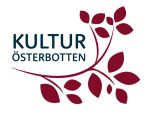Ateljé Stundars
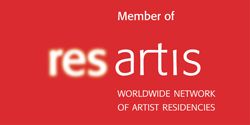
Ateljé Stundars – Who are We?
Ateljé Stundars, an international art residency founded in 1998, is a member of Res Artis: Worldwide Network of Arts Residencies and FAIRE, the Finnish Artist Residency Network.
Ateljé Stundars is run by KulturÖsterbotten, a division of the SÖFUK Federation of Swedish Municipalities in Ostrobothnia for Education and Culture (Svenska Österbottens förbund för utbildning och kultur, SÖFUK). SÖFUK, a joint municipal organization with fourteen member municipalities, is also in charge of the vocational education (Yrkesakademin i Österbotten) and the regional theatre (Wasa Teater) in Swedish-speaking Ostrobothnia.
Ateljé Stundars operates in conjunction and close co-operation with an open-air museum and centre of culture and art, the Stundars Museum, in the village of Solf in Korsholm, Finland.
For 2025, we have invited three Guest Artists to live and work at our residence for a period of four months each.
Artists participating in 2025: Work Plans
WORK PLAN:
I started a series of sun drawings during my first artist residency in Switzerland. It was inspired by the sun. The residency was in a valley in the Swiss mountains. The sun didn‘t shine for the first two months of the winter. That had a big influence on me and my way of working.
I would like to pick up where I left off during a possible stay in Finland. Since there are also months in Finland with no or very few hours of sunshine during the day, I think this is an exciting place for me to continue this series.
The sun drawing series shows the movement of the sun over different periods of time. I find it exciting how the process and transience of time is thematised. At regular intervals I draw the shadow of the sun on a sheet of paper. The sun is decisive and the author of the drawing. Like a photograph, time is captured in the Sun Drawings.
In my artistic practice I follow a methodology that reveals the process. I often find myself in a state of hesitation or doubt. I imagine that this emotional chaos is made visible in my work. I like the tension that results. Spontaneity and control are juxtaposed. I always look for a consistent solution in my paintings, and practical issues such as hanging often determine the appearance of the painting. One decision follows another. I try to follow a plan, but recognise happy coincidences as
such and include them in the process.
As I experienced during my first residency, this gives me the space I need and the freedom to work in this way. I haven‘t been able to work so freely since my residency in Switzerland. I would love to indulge in this process again to see what can happen.
Besides themes like time and the sun, I am also interested in materials. I try to experience them in my paintings. I try to empirically explore the properties and behaviour of different materials and incorporate them into my work. The conditions and space of the residency would allow me to do this.
The aim of my residency would be to create a completely new series of paintings. A series based on the influences and circumstances of being in Finland. I can imagine working with everyday materials from crafts or nature, such as the charcoal used to heat saunas or the local clay. This is just a first idea. I want to take the time to immerse myself in the environment. To familiarise myself with the land and the place. This is the key to my work. I would be delighted to have that opportunity.
Website: www.andreavera.ch
Artist name: Dennise Vaccarello
WORK PLAN:
During my stay at Solf, I plan to carry out a fiction-based project entitled 'A Little Bird Told Me'. This project is a fictional exploration of the surroundings of the residency to examine the permeability between the real and the oneiric, using the incubation of dreams through found objects to reflect on the landscape and context. The aim is to create a sculptural installation, a fictional video essay, and an artist's book inspired by the Söderfjärden crater.
With this project, I want to explore aspects that I have addressed in my previous work: artistic research as a narrative genre of fiction and an animist conception of landscape as a methodology for reflecting on nature. In more detail, my aims are:
1. To create a site-specific installation in the studio based on small sculptures that allow me to explore the limits between the ordinary and the extraordinary. Bearing in mind that when you travel to a new place, details such as the color of the stones, the change of light, or the environmental sound can be fascinating in contrast to what you are used to, I will use this fascination as a starting point for creating a dialogue with the site and its surroundings.
The idea is to collect elements of the landscape (wood, stone, roots, sounds...) and create a sculptural installation that simulates the map of an explorer of the cosmos, which will be used to search for the origins of the meteorite that created the crater.
In order to carry out this fictitious investigation, it will be necessary to develop, through dreams, the ability to read the past of objects. That is to say, during the day I will search for material and work with it, and at night I will search for it in my dreams. Hopefully, this search will lead me to imagine the world the meteorite came from, what it saw on the way, or what it felt like to be part of a new world.
2. All this research will be captured in a fictional video essay to reflect on the universe and how the perception of reality can be shaped through fiction and dreams. In other words, how the world we live in can be shaped through stories. The video will include images of the area, the artistic process, the search, dreams, and reflections, as well as a soundscape made with natural recordings of the area, such as its birds and people.
3. I will keep a record or diary of the experience during the stay, which will eventually form part of the project as an ‘artist's book’ where the dreams, sketches, and ideas that arise during its materialization will be recorded. A map of the sculptural installation will be included in it, so that when I dismantle the installation-space, a record of the piece will remain.
Website: www.dennisevaccarello.com
In co-operation with Pro Artibus Foundation.
PRESENTATION (in Swedish only):
by Curator Markus Åström, Pro Artibus Foundation
Konstnären Ruben Risholm ingår i Sinnes program Januari 2026, vilket gör att det faller sig naturligt att han arbetar under en residensperiod på Ateljé Stundars hösten 2025. Risholm utexaminerades år 2022 från Malmö konstakademi. Han bor och arbetar i Sverige. Hans figurativa konst fokuserar främst på människofigurer i trä, men han arbetar också i andra material som sten, metall och keramik. Han är intresserad av hur myter och sagor överförs vidare över generationer, hur bildkonsten förkroppsligar det ordlösa och omedvetna och hur konsten som tradition öppnar upp för en djupare förståelse mellan oss människor i ett längre perspektiv.
Risholms grovarbete sker utomhus med motorsåg och vinkelslip. Efter grovarbetet mejslar han fram den slutliga ytan med stämjärn i ateljén. Risholm är också intresserad av klockgjuteriet som är verksamt i området. Han skulle arbeta med lokalt trä som fällts på Stundars eller i närområdet. Det här skulle kräva att man förbererder med att torka på förhand utvalt virke.
Website: www.rubenrisholm.com
Risholm is represented by Gallerie Thomassen: www.gallerithomassen.se
What Do We Offer?
We offer our artists a peaceful rural environment with an excellent chance to concentrate on creative work. As of 2022, we invite three artists to live and work at our residence for a period of four (4) months each. There is only one artist staying with us at a time.
Our location and the facilites we offer are excellent for visual artists, painters, photographers and other artists who seek a peaceful place to concentrate on their work. Many of our artists have found great inspiration in the Stundars environment and in the surrounding nature.
We provide our artists with a studio and an apartment, both rent-free. The studio, right in the heart of the Stundars Museum area, is an excellent place to work for instance for a visual artist. The two-bedroom apartment just a stone's throw away from the studio is fully furnished and equipped.
A residency at Ateljé Stundars is free of charge. Our artists are paid a grant of 11 Euros a day to cover expenses for artist's supplies and materials.
Where Can You Find Us?
Ateljé Stundars is located in the village of Solf (in Finnish: Sulva) in Korsholm (in Finnish: Mustasaari), Ostrobothnia on the west coast of Finland.
The street address of the residence is: Stundarsvägen 5, FIN-65450 Solf, Finland.
Coordinates (Google Maps): 63.014666586826024, 21.644184369817264
What Do We Expect?
We expect our artists to join us with a solid work plan and a strong motivation to fulfill it. We strongly encourage all our artists also to engage in out-reaching activities and arrange artists talks, work shops, open studio events, exhibitions et cetera, both for the artist community in the region and for the general public. We expect all our Guest Artists to deliver at least one (1) Artist Talk (digital), either to fellow artists and/or art students or to the general public, during their time at our residence.
We expect our artists to pay all their travel expenses to and from our residence as well as their living expenses while staying with us – the grant of 11 Euros a day is for artist's supplies and materials only. We also expect our artists to have sufficient health insurance.
Interested in Joining Us?
...in 2025?
The year 2025 is booked solid at Ateljé Stundars. No new applications are accepted.
...in 2026 or later?
The plans for 2026 (and onwards) are not yet fixed. Information about our future plans will be published later this year.
All applications for participation in the Residency Program, received within the period of application, are put before the jurors of Ateljé Stundars. The jurors carefully study each application, especially the work plan and the work samples submitted by the applicants. The jurors also evaluate the artistic merits of each applicant. One of the most important questions the jurors have to consider is how successfully a certain work plan could be put into practice within the actual context of Ateljé Stundars.
Once the jurors have reached their decision, all applicants are contacted through email.
The jurors:
- Mr. Robert Back, Senior Lecturer, Novia University of Applied Sciences
- Ms. Johanna Halme, Art Educator, Pro Artibus Foundation
- Mr. Jimmy Pulli, Contemporary Artist, Vaasa
- Ms. Gunilla Sand, Museum Manager, Stundars Museum
- Mr. Peter Båsk, Senior Museum Advisor, Stundars Museum
- Ms. Åsa Blomstedt, Cultural Manager, KulturÖsterbotten / Svenska Österbottens förbund för utbildning och kultur (SÖFUK)
We are happy to answer any questions you may have about our residence. Please e-mail us at Den här e-postadressen skyddas mot spambots. Du måste tillåta JavaScript för att se den.!
2024
Tianyu Chen (China / Netherlands
Takatoku Nishi & Yumeo Nakayama (Japan)
Xiayi Su (China / Great Britain)
2023
Lenka Holikova (Czech Republic / Mexico)
Tanja Hamester (Germany)
Margot Araujo (France)
2022
Matilda Enegren (Finland)
Damla Tamer (Turkey / Canada)
Kirsimaria Törönen (Finland)
2021
Anisia Affek (Israel / Germany / Ukraine)
Ursula Sepponen (Finland / Sweden)
Diana Baumbach (USA)
2020
Jolene Mok (Hong Kong / UK)
Susanne Schär & Peter Spillman (Switzerland)
Andrea Coyotzi Borja (Mexico / Finland)
2019
Allison Roberts (USA)
Atefeh Majidi-Nezhad (Iran)
Jan Lütjohann (Germany)
Amanda Hellryd (Sweden)
2018
Hiram Wong (Australia / Hong Kong)
Minh Duc Pham (Vietnam / Germany)
Katrin Hotz & Jerome Lanon (Switzerland & France)
Susana Wessling (Portugal / UK)
2017
Hazel Barstow (UK / Norway)
Jo Ann Kronquist (Canada)
Juliana Irene Smith (USA / South Africa)
Behrad Hassanati (Iran)
2016
Shahrzad Malekian (Iran)
Cecilia Hultman (Sweden)
Barbara Tong (Hong Kong / UK)
Nicola Williams (UK)
Francesco Dipierro (Italy)
2015
Jane Hughes (Ireland)
Gloria Luca & Tudor Patrascu (Romania)
Anna Roberta Vattes (Germany)
2014
Anthea Bush (UK, Netherlands)
Bas Ketelaars (Netherlands)
Mariann Oppliger & Res Thierstein (Switzerland)
Johanna Kintner & Nora Mertes (Germany)
Heong uk Choi (Korea)
2013
Peter Luha & Lucia Cernekova (Czech Republic)
Soo Sunny Park (Korea, USA)
Christa Joo Hyun D'Angelo (Korea, USA, Germany)
Jochen Schneider (Germany)
2012
Rosalie Schweiker (Germany / UK)
Hanna Saks (UK)
Antje Pehle (Germany)
Sonja Hinrichsen (Germany / USA)
2011
Lisbeth Grägg (Sweden)
Anneli Holmstrom (Scotland)
Melania-Elisabeta Hangan (Romania)
Bas Ketelaars (Netherlands)
Anneli Holmstrom (Scotland)
2010
Andreanne Fournier (Canada)
Sophie Dvorák (Austria / Argentine)
Seungchee Kang (Korea)
Mathieu Leger (Canada)
2009
Michal Moskop (Germany / Israel)
Pamela Schilderman (Netherlands / UK)
James Kuehnle (USA)
Morgan Craig (USA)
Kyösti Linna (Finland)
2008
Eva Spikbacka (Sweden / Finland)
Hideki Kanno (Japan)
Maja Rohwetter (Germany)
Karin Kamijo (Japan)
2007
Britt Kootstra (Netherlands / Saudi Arabia)
Hanni Stolker (Netherlands)
Takashi Mitsui (Germany / Japan)
Eva Spikbacka (Sweden / Finland)
2006
Yoko Iida (USA / Japan)
Maria Petschatnikov (Germany / Russia)
Natalia Petschatnikov (Germany / Russia)
Markus Shimizu (Germany / Japan)
Dragos Alexandrescu (Romania)
Carla Cruz (Portugal)
2005
Samuel Nigro (USA)
Takehiro Mizumoto (Japan)
Sofia Bilius (Finland / Sweden)
Marina Kronqvist (Finland)
Karin Laaja (Sweden / Finland)
Britt-Lis Lindqvist (Sweden)
Catherine Davies (Wales)
Helen Malia (Wales)
Jeroen van de Ven (Netherlands)
2004
Sven Eggers (Germany)
Bente Lise Jakobsen (Norway)
Marianne Høyland (Norway)
Ronan Caulfield (UK)
Sally Timmons (Ireland)
Christer Carlstedt (Sweden)
Sigita Blaziunaite (Lithuania)
Samuel Nigro (USA)
2003
Bojana Romic (Yugoslavia)
Annukka Laine (Finland)
Tatsuo Hoshika (Finland / Japan)
Sari Carel (USA / Israel)
Ingela Sand (Sweden)
Sven Eggers (Germany)
2002
Janika Herlevi (Finland)
Anna Rossow (Finland)
Tomas Kulistak (Czech Republic)
Annukka Laine (Finland)
Tatsuo Hoshika (Finland / Japan)
Haruka Furusaka (Japan)
Eva Kobylarczyk (Poland)
2001
Asta Rakauskaite (Lithuania)
Renate Wincken (Netherlands)
Carme Bosch (Spain)
Dolores Bosch (Spain)
Teresa Nogues (Spain)
Janika Herlevi (Finland)
2000
Maxine Adcock (UK)
Merja Ylitalo (Finland)
Panu Thusberg (Finland)
Hanne Ivars (Finland)
Mary Stechschulte (USA)
Asta Rakauskaite (Lithuania)
1999
Maxine Adcock (UK)
1998
Ulrike Kuschel (Germany)
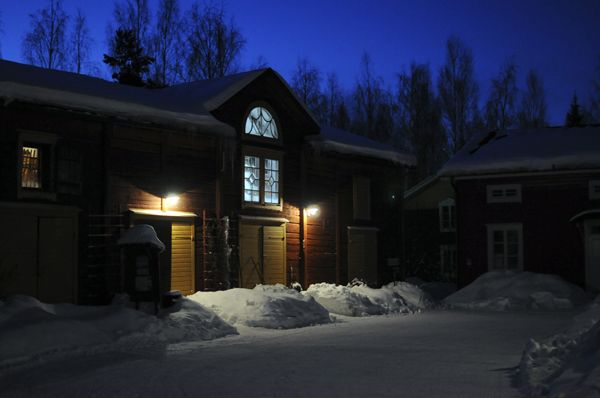
Studio
The Ateljé Stundars studio is housed right at the heart of the Stundars Museum area, in the attic of a beautiful traditional wooden house.
The studio has a large window facing north. On a bright summer day, the natural light coming through the window is quite sufficient, but most days artificial light is needed. The studio therefore has strong electrical light.
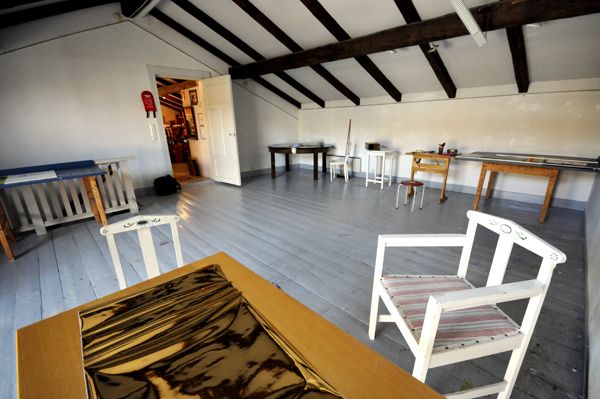
The 60 m² studio is equipped with tables and chairs and an easel. Basic artist's supplies and materials can be bought in Vasa, but we advise our artists to bring as much with them as possible, at least crucial supplies and material.
The studio shares the attic with the Stundars Museum Office. There is a door between the office and the studio.
The stairs leading up to the attic are quite steep. The studio is therefore not handicapped-friendly.
Even though winters in Finland may be bitterly cold with temperatures down to -20 degrees Centigrade, the studio offers a warm and dry place to work.
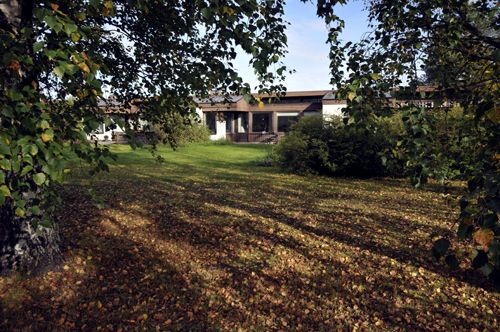
Apartment
The artist’s apartment is situated in a terrace house some 200 metres from the studio. It consists of two bedrooms, a living room, a kitchen and a bathroom / toilet.
The apartment is quite spacious (75 m²) with big windows in the living room (and kitchen) facing south. Many of our artists have used the living room as a home studio. The windows in the two bedrooms face north.
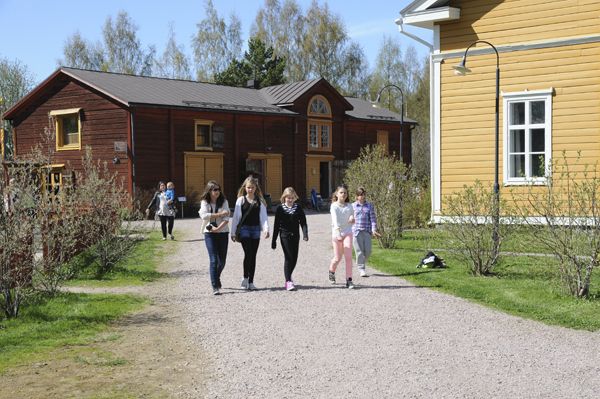
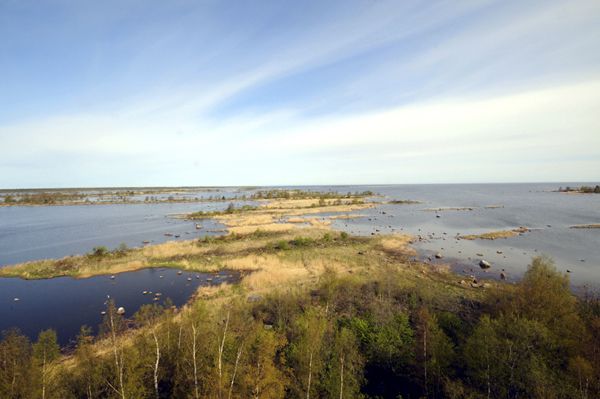
Surroundings
The artist residence operates in conjunction with an open-air museum and centre of culture and art, the Stundars Museum. The Stundars area is quite busy, especially during the summer, with a lot of activity going on: crafts days, exhibitions, concerts, children’s events, time travel etc. There is also a small gift shop-cum-café in the area.
Ateljé Stundars is surrounded by open plains with a rich bird life. Deep forests and a beautiful archipelago can be found within biking distance from the studio.
The 520 million-year-old meteorite crater of Söderfjärden lies within walking distance from the residence. Today the circle-shaped cultivated crater plain is one of the most interesting geological sites in Finland and a true paradise for bird watchers in both spring and autumn. From the bird-watching tower you can on a good day observe thousands and thousands of migrating cranes, swans and geese.
Meteoria, a visiting centre right in the middle of the crater, features an advanced exhibition of the entire history of Söderfjärden. There is also a well-equipped astronomical observatory with a telescope for studies of celestial bodies hundreds of millions of light years out into the universe.
The Region
The village of Solf is part of the municipality of Korsholm. With its 20,000 inhabitants Korsholm is the third largest municipality in the region of Ostrobothnia. The closest city is Vasa (in Finnish: Vaasa), some 17 kms north of Solf. Vasa with its 60,000 inhabitants has a rich cultural life and offers a number of interesting museums and galleries, for instance
- the Ostrobothnian Museum
- the Kuntsi Museum of Modern Art
- the Tikanoja Art Museum
- the Museum of Old Vaasa
- Platform (artist-run initiative)
- Black Box Genesis
- Black Wall Gallery.
In Jakobstad (in Finnish: Pietarsaari) some 100 kms north of Vasa, the Novia University of Applied Sciences offers a Master's programme in culture and art. Degree programmes in arts and culture is offered also by the YA – Vocational College of Ostrobothnia. Both operate at the Campus Allegro in the city centre.
There is also an artist residence in Jakobstad, AiR Jakobstad.
The Kvarken Archipelago is the only natural heritage on Unesco's World Heritage List in Finland. The area received the World Heritage status because it is the best place on earth to witness and observe the unique geological phenomenon of land uplift.
Bilingual Finland – Bilingual Ostrobothnia
Finland is a bilingual country with two national languages: Finnish and Swedish. The Swedish-speaking population is concentrated on the west and south coast of Finland as well as on the Åland Islands.
The region of Ostrobothnia with some 180,000 inhabitants is the only region on the mainland with a Swedish-speaking majority. Many people are bilingual and speak both Finnish and Swedish, but there are people, especially among the elderly, who are not able to communicate in the other national language.
Most people in Finland speak English quite well.
Kungsgårdsvägen 46 A, 65380 VASA, FINLAND
Den här e-postadressen skyddas mot spambots. Du måste tillåta JavaScript för att se den.
+358 50 347 0522


